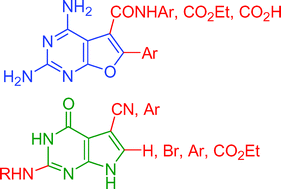Diversity oriented syntheses of fused pyrimidines designed as potential antifolates†
Abstract
Diversity oriented syntheses of some furo[2,3-d]pyrimidines and pyrrolo[2,3-d]pyrimidines related to

* Corresponding authors
a
WestCHEM, Department of Pure & Applied Chemistry, University of Strathclyde, 295 Cathedral Street, Glasgow, Scotland
E-mail:
c.j.suckling@strath.ac.uk
Fax: +44 141 548 5743
Tel: +44 141 548 2271
b
Strathclyde Institute for Pharmacy and Biomedical Science, University of Strathclyde, 29 Taylor Street, Glasgow, Scotland
E-mail:
a.l.harvey@strath.ac.uk
Tel: +44 141 548 4155
c
Division of Biological Chemistry and Drug Discovery, College of Life Sciences, University of Dundee, 1 Dow St, Dundee
E-mail:
w.n.hunter@dundee.ac.uk
Fax: +44 1382 385764
Tel: +44 1382 385745
Diversity oriented syntheses of some furo[2,3-d]pyrimidines and pyrrolo[2,3-d]pyrimidines related to

 Please wait while we load your content...
Something went wrong. Try again?
Please wait while we load your content...
Something went wrong. Try again?
C. L. Gibson, J. K. Huggan, A. Kennedy, L. Kiefer, J. H. Lee, C. J. Suckling, C. Clements, A. L. Harvey, W. N. Hunter and L. B. Tulloch, Org. Biomol. Chem., 2009, 7, 1829 DOI: 10.1039/B818339B
To request permission to reproduce material from this article, please go to the Copyright Clearance Center request page.
If you are an author contributing to an RSC publication, you do not need to request permission provided correct acknowledgement is given.
If you are the author of this article, you do not need to request permission to reproduce figures and diagrams provided correct acknowledgement is given. If you want to reproduce the whole article in a third-party publication (excluding your thesis/dissertation for which permission is not required) please go to the Copyright Clearance Center request page.
Read more about how to correctly acknowledge RSC content.
 Fetching data from CrossRef.
Fetching data from CrossRef.
This may take some time to load.
Loading related content
